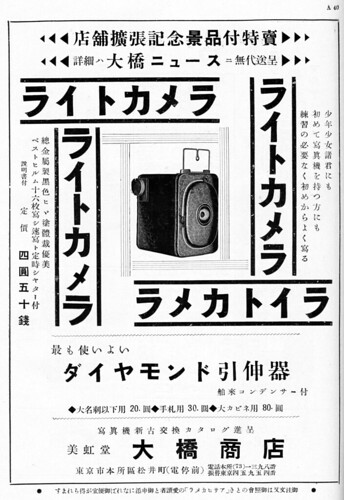Light (3×4)
The Light or Light Camera (ライトカメラ) is a Japanese camera taking 3×4cm pictures on 127 film. It is mainly known from an advertisement in the May 1929 issue of Asahi Camera, placed by the distributor Ōhashi Shōten. The name "Light" was used on other Ōhashi cameras, such as the Baby Light and Roll Light Ref.
Contents
Context
The Light seems crudely made and was very inexpensive: the price is given as ¥4.50 in the May 1929 advertisement, and the camera is described as "for young boys, young girls and beginners".[1] It is however notable for being the first known Japanese camera specifically made for 3×4cm exposures, and perhaps the first such camera in the world, predating the Zeiss Ikon Kolibri by one year. It was followed by the Baby Sport, another inexpensive 3×4cm camera by the same company.
Description
The Baby Sport is an all-metal box camera, covered with crackled black paint. The viewfinder is a simple wireframe hinged at the top, and no eyepiece is visible. The film is advanced by a knob on the photographer's right; the advance is probably controlled by red windows but the details are unknown.
The lens is certainly a meniscus and seems to have a fixed aperture; it is surrounded by an oval bulge. The shutter has Time[2] and Instant settings, perhaps selected by a lever visible near the top; the release lever is on the side of the bulge and is actuated by the photographer's right hand. No markings are visible in the only available picture.

|
| Advertisement published in the May 1929 issue of Asahi Camera. (Image rights) |
Notes
- ↑ Advertisement in Asahi Camera May 1929, p.A40.
- ↑ The advertisement has teiji 定時, probably meaning "Time", but it can conceivably mean "Bulb" exposures.
Bibliography
- Asahi Camera. Advertisement by Ōhashi Shōten in May 1929, p.A40.
- Lewis, Gordon, ed. The History of the Japanese Camera. Rochester, N.Y.: George Eastman House, International Museum of Photography & Film, 1991. ISBN 0-935398-17-1 (paper), 0-935398-16-3 (hard). P.43 (brief mention only).
The camera is not mentioned in Sugiyama.
